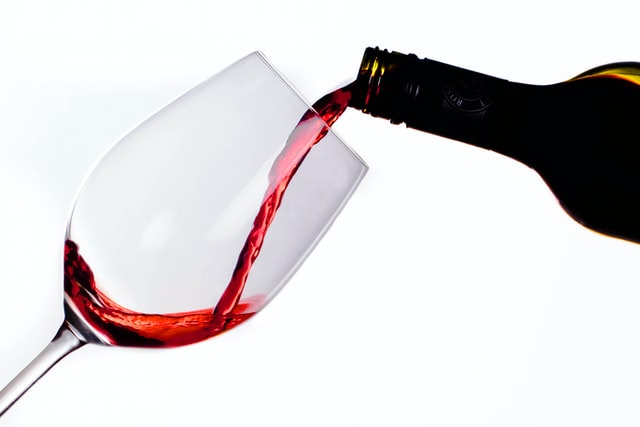
Photo by Apolo Photographer on Unsplash
When thinking about storing wines, most of us have a basic understanding that white wines should be stored using colder temperatures than red wines. The reality, however, is that there are specific temperatures that are ideal for wine storage and preservation.
Understanding the optimal temperatures and methods for storing and preserving wine is essential for bringing out a wine’s best aroma and flavor. Temperatures will vary depending on the type of wine being stored.
In this post, we will explore the proper temperatures to store different types of wine at, as well as why wine temperature makes such a difference. Keep reading to learn more about how to best preserve your wines – and how a Wineemotion preservation system can help.
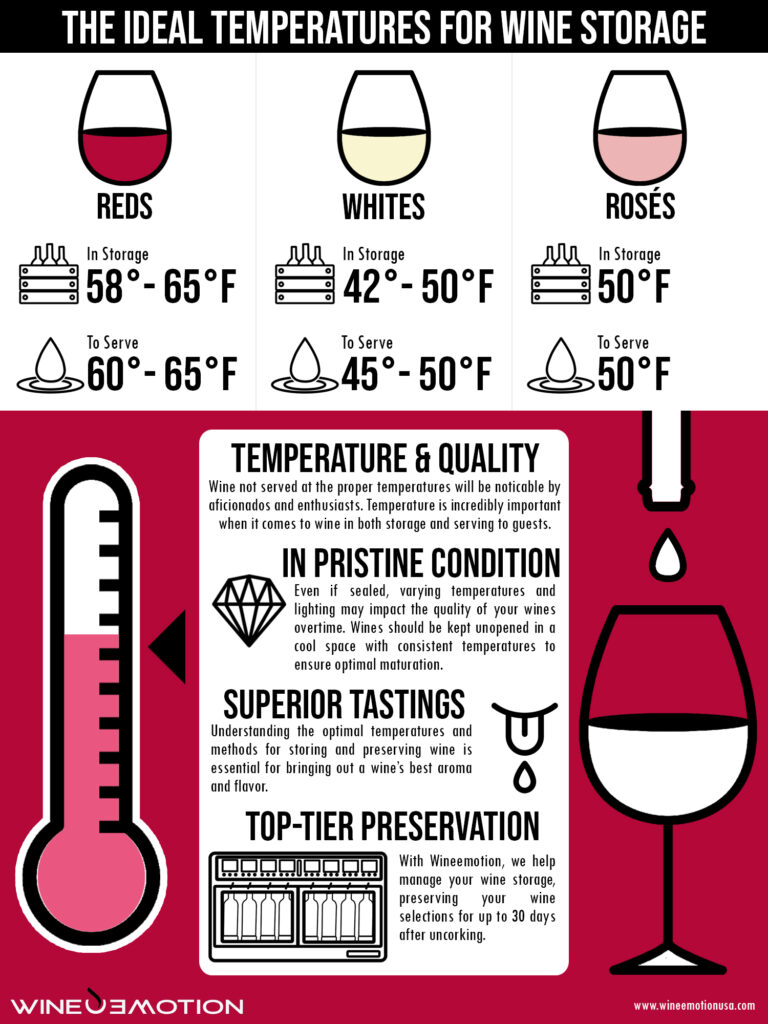
When it comes to storing different types of wines, there is a good bit of variance in terms of temperature depending on whether the wine is a red, white, or rosé.
Additionally, there may be some difference in required storage temperature according to whether or not the wine has been opened. Opened bottles of wine are exposed to the air, which can cause oxidation and other chemical processes that negatively affect the wine’s flavor over time.
Here is a quick run down of the best storage temperatures for red, white, and rosé:
Many red wine enthusiasts prefer reds to be served a few degrees below room temperature, generally in the 60 – 65 degree Fahrenheit range. As such, the ideal storage temperature ranges approximately between 58 – 65 degrees Fahrenheit – but no higher than 70 degrees.
When it comes to unopened red wine, much of the flavor and aroma is trapped inside the bottle thanks to the traditional corking and sealing method. This will do most of the work in terms of preservation, provided the bottle is kept in a relatively dark space as sunlight can warm the contents of the bottle over time, such as a dedicated wine cellar.
As for opened red wine, some choose to refrigerate opened bottle while others choose to leave them in an external storage location that stays closer to room temperature, such as a cabinet.
Because most fridges stay in the 40 – 45 degree range, it can be tempting to leave opened red wine out. However, as mentioned the wine becomes vulnerable to chemical processing once it has been exposed to air. By refrigerating red wine, this process is slowed considerably.
Colder temperatures do not cause harm to red wine, they just may not be the ideal serving temperature. If red wine is stored in a colder environment, it should be brought out around half and hour before serving to allow it to settle at a more suitable temperature for drinking.
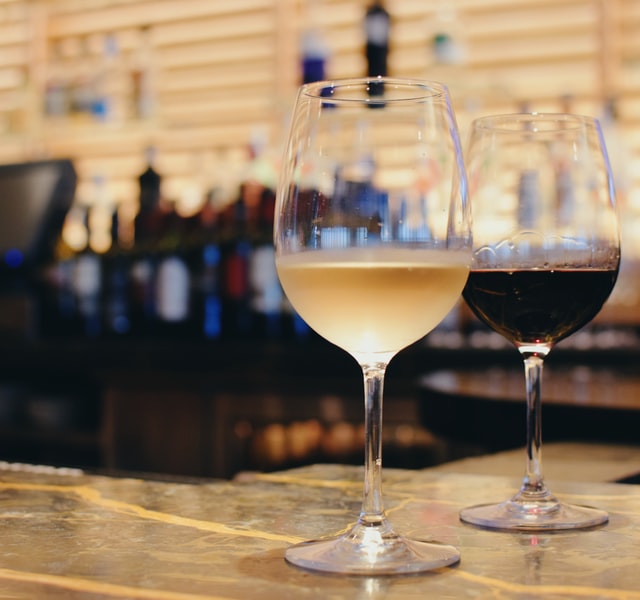
Photo by Jordon Kaplan on Unsplash
Unlike red wine, which is generally preferred to be drank and stored just below room temperature, white wine is typically served chilled. As such, the optimal storage temperature for white wine is lower – around 42 – 50 degrees Fahrenheit.
Similar to red wine, the most preferred temperature for serving white wine is within the upper range of the acceptable storage temperatures – around 45 – 50 degrees Fahrenheit, typically. This is because while coldness may be good for their preservation, white wines become more flavorful as they approach room temperature.
Traditional refrigerators are the most commonly used method for keeping white wines chilled before serving, for both opened and unopened bottles. Unopened bottles may also be kept in wine cellars with bottles of reds, as most wine cellars stay around 55 - 60 degrees Fahrenheit.
Rapidly changing temperatures pose a threat to the quality of wine, so moving them from a cold space to a warmer space repeatedly is generally advised against, and consistency in temperature in the storage location is a must.
Rosé is a type of wine that falls in between the categories of red and white, and as such, the storage temperature requirements are essentially the median between the two. The ideal temperature range when storing rosé is around 50 degrees Fahrenheit.
Unopened bottles can easily be kept in a dark cellar-like space or other place of storage where the temperature is consistent, while opened bottles should be refrigerated.
Rosé wines are, in fact, made from the same red grapes that red wines come from. They are made into rosés by lessening the time in which the flesh and juice of the grape is soaked with the skin, where much of the flavor and pigment comes from - hence why rosés can be stored and served at higher temperatures than white wines.
| Variety of Wine | Serving Temperature | Place in Refrigerator for: |
|---|---|---|
| Cabernet Franc | 60° F | 15 Min |
| Cabernet Sauvignon | 60-65° F | 10-15 Min |
| Champagne/Sparkling Wines | 45° F | 30-40 Min |
| Chardonnay | 50° F | 30 Min |
| Malbec | 60-65° F | 10-15 Min |
| Merlot | 60-65° F | 10-15 Min |
| Pinot Gris | 45-50° F | 30-40 Min |
| Pinot Noir | 55-60° F | 15-20 Min |
| Red Bordeaux | 60-65° F | 10-15 Min |
| Riesling | 45-50° F | 30-40 Min |
| Rosé | 50° F | 30 Min |
| Sauvignon Blanc | 45-50° F | 30-40 Min |
| Syrah | 60-65° F | 10-15 Min |
| Viognier | 50° F | 30 Min |
| White Bordeaux | 50° F | 30 Min |
| Zinfandel | 60-65° F | 10-15 Min |
To put it simply – temperature is incredibly important when it comes to wine. While wine aficionados will identify immediately when a wine is not served at the ideal temperature, even those with untrained palettes are likely to notice the difference in taste when a wine is served outside of the preferred temperature range.
As covered, there are optimal temperatures for different wines to be stored at that will impact the overall quality of the wine. Unopened bottles can generally be stored in slightly warmers areas, but it is best to keep open bottles in a colder location to slow down oxidation and other chemical processes.
As for serving wine, the preferred serving temperature for red wine is closer to room temperature, while whites and rosés are better chilled. This is because there are certain, optimal temperatures at which different types of wine have their best flavor and aroma.
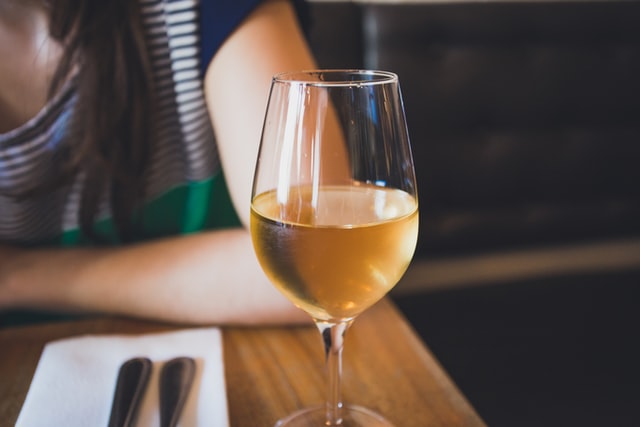
Photo by Jp Valery on Unsplash
While colder temperatures in the 40 – 50 degree range may dull the flavors of wine, this is easily solved by letting the wine warm up for a short period of time before consuming it.
However, warmer temperatures that are above the average room temperature of 70 degrees Fahrenheit can cause wine to age at a much quicker rate, causing it to lose quality quickly through a hastening of the aging process.
Ideally, wines should be kept unopened in a cool space with consistent temperatures to ensure optimal maturation. It is massively important to keep both opened and unopened wines out of direct sunlight, as this will contribute to an unwanted sharp increase in the warmth within the bottle, even if the temperature of the room is within the wine’s range.
Aside from storing bottles of wine in the correct, consistent temperatures, there are additional methods and techniques for storing wine so that it lasts longer and maintains its quality and freshness. Here are a few common ways wine is stored:
• Wine Cellars: Dedicated wine cellars are ideal for unopened bottles of red wine, though they can also be used for rosé and white wine if the cellar is kept at a cool enough temperature. A cellar is generally a small to medium size temperature-controlled room that does not let in any natural light that could disturb the quality of the wine.
• Refrigerators: Both personal and commercial use refrigerators can be used to store wines, though they will likely make the wine too cold, meaning that it will need to be allowed to rest at room temperature for a period of time before serving.
• Wine Dispensers: A wine dispenser is a behind-the-bar system that stores bottles of wine at precise temperatures, while also allowing for them to be used and open without losing quality. This is an especially useful option for business within the hospitality industry that need to store wines that are served by the glass on a regular basis.
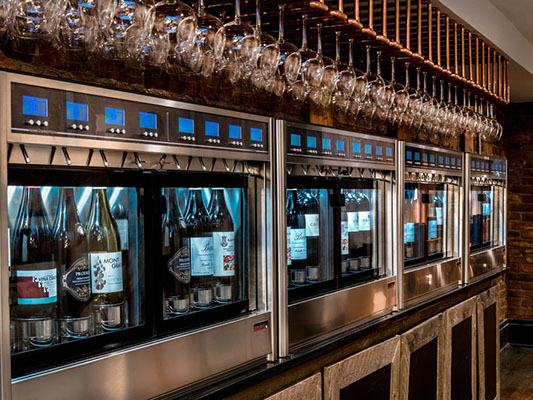
Here at Wineemotion, we have created all-in-one wine dispenser systems that can be used to store, preserve, and serve wines at the perfect temperatures. While simply storing open bottles in refrigerators may only preserve the quality of a wine for a week or two, Wineemotion’s dispensers can preserve wines for up to 30 days.
These systems are designed to enhance services offered by businesses and professionals within the hospitality industry. As such, implementation of our dispensers can provide a significant return on investment, as well as helping to cut additional costs. These additional decreases in cost include:
• An elimination of overpouring that leads to a waste of wine
• A reduction of waste through the extended preservation of wine, giving longer opportunity for the wine to be served and sold
• Greater customer satisfaction thanks to wines being served at the exact temperatures that are optimal for wine consumption
The Quattro +4 is Wineemotion’s latest model of wine dispensers, and its dual temperature zone technology makes it all the more worthwhile of an investment. Dual zones allow for two different temperatures to be set for specific bottles, meaning that both red and white wines can be stored at their optimal temperatures simultaneously.
The exactness of Wineemotion’s temperature technology is designed to satisfy even the most sophisticated palettes. Furthermore, you can choose between a 4, 5, 6, or 8-bottle dispenser, each with dual zones to allow for the serving of both reds and whites.
Contact Wineemotion today to get an official quote for your wine dispensing product.